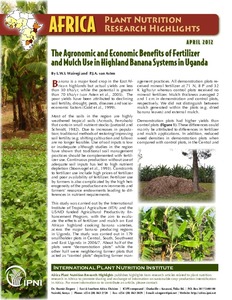| dc.contributor.author | Wairegi, L.W.I. |
| dc.contributor.author | Asten, Piet J.A. van |
| dc.date.accessioned | 2019-12-04T11:07:44Z |
| dc.date.available | 2019-12-04T11:07:44Z |
| dc.date.issued | 2012-04 |
| dc.identifier.citation | Wairegi, L.W.I. & Van Asten, P. (2012). The agronomic and economic benefits of fertilizer and mulch use in highland banana systems in Uganda. Africa Plant Nutrition Research Highlights. |
| dc.identifier.uri | https://hdl.handle.net/20.500.12478/1552 |
| dc.description.abstract | Banana is the most important food crop in Uganda. However, there has been a decline in productivity, attributed to declining soil fertility, drought, pests and diseases and crop management factors. This study aimed to explore the possibility of increasing yields through the use of fertilizer and mulch, and to evaluate the benefits of these inputs across the major banana producing regions in Uganda. This study was carried out in 179 smallholder plots in Central, South, Southwest and East Uganda in 2006/7. Half of the plots were ‘demonstration plots’ of an agricultural development project, while the other half were neighboring farmer plots that acted as ‘control’. Demonstration plots received mineral fertilizer (100% of plots), averaging 71 N, 8 P, 32 K kg ha−1 yr−1 and external mulch from grass and crop residues (64% of plots), whereas control plots received no mineral fertilizer and little external mulch (26% of plots). Demonstration plots had significantly (P ⩽ 0.05) higher yields than control plot in Central, South and Southwest, but average yield increases varied from 4.8 t ha−1 yr−1 (Southwest) to 8.0 (Central), and 10.0 (South). Average weevil corm damage (3%) and nematode-induced root necrosis (7%) was low and similar for both plot types, so yield increases could only be explained by the use of fertilizer and mulch. The highest demonstration plot yield increases were observed where fertilizer addressed key nutrient deficiencies identified using the compositional nutrient diagnosis approach. Farm gate bunch prices declined from 0.17 (Central Uganda) to 0.07 USD kg−1 (Southwest Uganda). Consequently, average marginal rate of return (MRR) of fertilizer and mulch use ranged from 0.1 (Southwest) to 5.8 (Central). The technologies were likely to be acceptable to farmers (MRR ⩾ 1.00) up to 160 km away from the capital. Fertilizer use is likely to be acceptable in all regions (MRR = 0.7–9.4) if local fertilizer prices of 2006/7 (average USD 0.56 kg−1 of fertilizer) declined by 50%. Doubling of fertilizer prices is likely to make fertilizer use unacceptable beyond 100 km away from the capital. The study concludes that there is scope for increased input use in banana systems in Uganda, but that regional variations in crop response, input/output prices, and price fluctuations have to be taken into account. |
| dc.description.sponsorship | United States Agency for International Development |
| dc.language.iso | en |
| dc.subject | Distance To Market |
| dc.subject | Farm Gate Prices |
| dc.subject | Fertilizers |
| dc.subject | Mulch |
| dc.subject | Nutrient Deficiencies |
| dc.subject | Profitability |
| dc.title | The agronomic and economic benefits of fertilizer and mulch use in highland banana systems in Uganda |
| dc.type | Journal Article |
| dc.description.version | Peer Review |
| cg.contributor.crp | Roots, Tubers and Bananas |
| cg.contributor.affiliation | International Institute of Tropical Agriculture |
| cg.contributor.affiliation | Makerere University |
| cg.coverage.region | Africa |
| cg.coverage.region | East Africa |
| cg.coverage.country | Uganda |
| cg.authorship.types | CGIAR and developing country institute |
| cg.iitasubject | Banana |
| cg.iitasubject | Soil Fertility |
| cg.iitasubject | Integrated Soil Fertility Management |
| cg.journal | Africa Plant Nutrition Research Highlights |
| cg.howpublished | Formally Published |
| cg.accessibilitystatus | Open Access |
| local.dspaceid | 82113 |
| cg.identifier.doi | https://dx.doi.org/10.1016/j.agsy.2010.06.002 |

